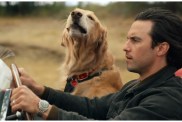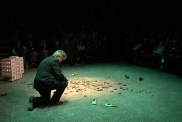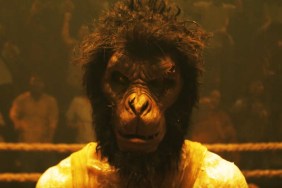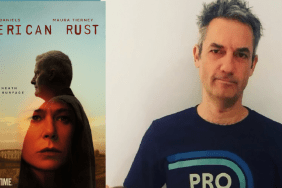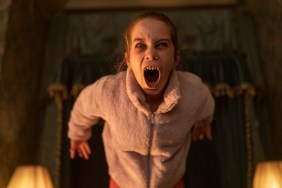For nearly every actor, the dream job would be to take on a role that allows them to disappear into their character and for actor Andy Serkis, that dream job has turned into a niche that’s made him one of the most respected actors who rarely appears as himself on screen. And yet, every single motion and emotion he does on set does appear through his characters as he’s helped evolve the art of performance capture acting.
From 2001 to 2003, Serkis brought one of J.R.R. Tolkien’s “The Lord of the Rings” characters to life, making the tragically misunderstood Gollum one of the most beloved screen characters of the early 21st Century in Peter Jackson’s trilogy. That one performance capture character brought Serkis enough respect that many thought he deserved an Oscar nomination for the performance. He followed that by playing two humanistic apes, including the giant one at the heart of Jackson’s King Kong and one named Caesar in last year’s Rise of the Planet of the Apes.
Both Serkis and Gollum are back for Jackson’s return to the series with The Hobbit: An Unexpected Journey, the first of a three-part prequel to the “Lord of the Rings” series. Gollum has one extended sequence with Martin Freeman’s Bilbo Baggins, but Jackson decided Serkis was ready to step up his involvement, hiring him as the film’s second unit director, which is a very big job for anyone.
ComingSoon.net has spoken to Serkis a number of times over the years, which helped us build a strong enough rapport that we could talk about a lot of different things in our latest interview, including the evolution of the art and technology of performance capture and why so many people in the industry still don’t respect it enough as real acting to nominate it for awards.
ComingSoon.net: Not many actors get a chance to revisit a character, let alone 10 years later with 10 years of experience, so what were you able to bring to Gollum this time with what you’ve learned in those ten years?
Andy Serkis: Wow. Gollum, he has never really been too far away from me, to be honest. He’s always been lurking there, he’s always been sort of in the background to everything. I suppose because Gollum is a character who’s also hitched to a whole sort of new technology and a way of working and the whole performance capture realm opened up from that point and began to be a modus operandi really after Gollum was established through those first three films. So yeah, in fact coming full circle back to Gollum, we’d arrived technologically at a point where obviously after “Apes” and so on, where we were doing live performance capture on set with other actors as opposed to acting with the other actors and then having to kind of do the actual motion capture part at a separate volume. That was very cool to see that trajectory coming around and enabling us to play out the scene, the riddles in the dark passage, which is the first thing that’s shot in the movie.
CS: Oh really? It was?
Serkis: Yeah, it was the first couple of weeks. We shot it as an entire sort of chamber theater piece from beginning to end, just kept redoing it. Pete wanted to do that to allow Martin to find Bilbo, rather than having to start Bilbo Baggins off with 13 dwarves and a wizard and multiple eye-lines and so on and so forth. He thought it’d be really good for Martin to be able to focus on one of the most intense one on one scenes, I suppose. For me, playing the part, I suppose one of the difficulties I faced was that Gollum had been sort of absorbed into public consciousness in such a big way and I had heard lots of impersonations of him in the meantime, loads. So regaining him, re-owning him was quite a challenge, rather than me feeling like I was doing an impersonation of lots of other people’s impersonations of a character I played 12 years ago.
CS: It’s amazing how people embraced Gollum. I don’t know if he’s like that dog you find by the side of the street who might bite you or something. Everyone literally loves Gollum.
Serkis: He’s so flawed. He’s so human in so many ways. His emotional range is very wide and he can flash and turn and you can feel sympathy for him and then hate him the next second. I think that’s the appeal of the character. There is a sense of a pity for this lonely creature that has no friends and is addicted to this thing that tortures him. In the film, we meet him and all throughout the scene, he doesn’t know that he’s lost the ring. The Smeagol part of his personality is really excited about finally having some company after being in the Misty Mountains by himself for 540 years. In the book, it’s not so defined, the Gollum-Smeagol split personality thing, but because we’d established that in “The Rings,” we thought it was important to do that as a signature part of his character, that we kept that. It’s also a little more interesting to have Bilbo confront not one, but two crazy sort of personalities in that cave.

CS: Even compared to the “Lord of the Rings” movies, you have a lot more performance capture characters in this one. You have the trolls as performance capture as well as the Goblin King, I imagine?
Serkis: That’s right.
CS: So were you able to do some of that stuff at your studio, The Imaginarium?
Serkis: No, it was all shot in New Zealand. Directing on the second unit, we did a little bit of work with the trolls, but mostly, it just so happened, because I was directing the second unit for 200 days, it was huge. Most of my job in fact. I did two weeks reprising the role of Gollum, and then I spent the rest of the year and a half in the blocks that we were there, directing the second unit, so that was the big, big part of the job for me.
CS: How did that come about? Was it just kind of like, “Okay, we’re done with the Gollum scene, now can you just stay here and do second unit?”
Serkis: No, it was about a month before principal photography. Pete said, “Look, I’d really love you to come and continue the journey with us after you finish playing Gollum.” He’s known that I’ve wanted to direct and he knew that I was setting the Imaginarium up and setting film projects up to direct. All the way back to “Rings,” actually, he knew that I’d been directing videogame projects and short films. I was setting up to direct my first feature. He just said, “This would be really great. This would be really cool.” Because the second unit on something of that scale involves the main cast coming and sharing main cast quite a lot, because of the size of the company, because of the ensemble, he wanted someone who could be a guardian of performance, as they came over to the second unit. So, although there were technical things, for sure, that I hadn’t engaged with before like 3D and obviously not 48 frames a second, I knew that I’d be able to at least provide an atmosphere for the actors to work in. I had a very good technical team around me. I’ve got a growing sense of directing, technologically as well. We had a really great relationship and I would set the scenes up. We shot basically everything from drama to all the aerials to all the battle sequences and really quite big stuff.
CS: Did you shoot any of those scenes of the group walking across Midde-earth?
Serkis: Yeah, yeah. That was all me in the helicopter, yeah.
CS: I always wondered. Do they just fly the actors out to some remote place and they start walking?
Serkis: For sure, for sure.
CS: You’ve worked with the effects department quite a bit over the years because you had to out of necessity, so was it working with them as a second unit director?
Serkis: Because you’re hand in glove with them all the way along, obviously on set, you know, you have a visual effects supervisor there who’s great. I mean, I feel very comfortable with that side of things now, really from when I started, which is I had no idea about that stuff. But it’s just in the key relation of skills, I suppose, that I picked up over the years. So, yeah, I mean, interestingly, the sets that were designed and built by the art department, beautiful sets, one of the main tests wasbecause Pete’s all about the sets, no matter how beautiful they are, and you want to shoot them and you want to shoot the actors in them. It was always, the camera would always be like, three quarters of the screen green, the green screen, and I’d be using tiny elements of the set. So, that was a big sort of learning curve for me. It’s just like, you can’t just indulge in the beautiful artistry that’s in front of you. It’s very much about keeping the imagination open for framing it, kind of third framing it so that you’ve got lots of green screen behind to open that up. That was an interesting kind of part of the journey, I suppose.
CS: One of the bigger scenes in the movie was when they’re being chased by goblins and that’s literally thousands of them, so what’s that like on set? Do you have hundreds and hundreds of extras?
Serkis: Weta created a system during “Lord of the Rings” called Massive, which is artificial intelligence CG characters, so there’s some of that. You have a number of maybe 60 to 100 or something which you use in the foreground, then of course the rest are CG characters.
CS: There are a lot of big scenes in this movie. You’re not saving it for the last movie.
Serkis: Oh no, no, no. The rollercoaster sort of builds as you experienced it. It sort of really starts to rock a third of the way through the movie, it really kicks into gear.

CS: Do you have to go back and shoot more stuff for a third movie?
Serkis: At the moment, there’s no plans. I mean, there will be some more stuff for the third movie, but Pete’s probably going to just handle that on his own because we have shot a lot of material.
CS: You shot all the main battles you need to do?
Serkis: There’s still the Battle of Five Armies very much needs to be shot, but I think Pete wants to do that by himself.
CS: What about Gollum? You’ve shot all your Gollum stuff already?
Serkis: I believe. (Laughs) But never say never is the rule of thumb I live by now because Pete might just
that’s the great thing. As a writing team, he and Fran and Phillipa will have ideas organically. They might well say, “Well, maybe call him back.” I don’t know, but certainly there’s no plans at the moment, but as I say, never say never.
CS: Also, you’re going to do a sequel to the “Apes” movie and bring back Caesar, another amazing character. When are you going to start that? Are you going to be more involved and might you use your studio for parts of that?
Serkis: Well, the Imaginarium has been doing some consultancy. We’ve done a little bit of pre-testing for “Apes,” with some of the characters. Matt Reeves is now the new director of the second movie, so I’ve been in discussion with him and hopefully will do some work with him and kind of evolve with some of the characters, but yes, we’re due to start towards the end of the first quarter next year.
CS: What about the movies you want to direct? George Orwell’s “Animal Farm” is an amazing book and I’m happy someone’s going to try and tackle it.
Serkis: Yeah, I’m very excited about that. I mean, that will be the Imaginarium’s first major outing. We’re proof of concept-ing that at the moment. It’s all going to be performance capture, but using hybrids of performance capture with other elements of using, for instance, experimenting at the moment with using part facial performance capture with puppeteered elements, which are markered up, so that you can control a performance. So yeah, it’s a really sort of interesting phase at the moment.
CS: I haven’t read the book in a long time. Does it still stand up?
Serkis: Oh yeah. We’re taking it from the point of view of if Orwell were writing “Animal Farm” for today, where would his targets be? I mean, it’s a fairytale and we’re keeping it as a fairytale and a fable, which will allow us to satirically pick our targets.
CS: Who’s writing the screenplay?
Serkis: Not announced yet. We’re just about to announce it. We’re so close, but I can’t mention it.
CS: So you’ll probably finish “Apes” first before you even tackle that, I guess?
Serkis: Well, the thing is, because of the way of shooting it, using performance capture, you can pre-vis and sort of start working on it now. So we’re very much into it now in terms of character designs, concept with our art department, all of that stuff is going on right now. We aim to shoot it at the end of 2013.
CS: For “Apes,” because you’ve done a lot of the development and preparation, I have to assume a sequel will be a lot easier.
Serkis: It should be. The interesting thing will be now how Caesar operates in a world which is, now because of the virus that hits at the end of the first movie, how Caesar kind of brings an accord between apes and the surviving humans. That’s going to be kind of, it’ll just be interesting where we take that.
CS: Yeah, I’m curious how many movies they fit in before it gets to the original movie.
Serkis: Yeah, exactly. (Laughs)
CS: You probably can fit in a lot. A lot of people loved that movie last year, as did I. It was a nice surprise in a summer full of big superhero movies.
Serkis: That’s right. Yeah, I was really nice and I was thrilled that people liked it.

CS: You’d been acting for a long time doing theater and then you played Gollum and you transitioned into performance capture and it’s really been your niche for a long time. Is that at all how you envisioned your career?
Serkis: No, I mean, it really did take a complete left field turn. I was just concentrating on acting. I’d started writing, actually, and wanted to make films, so that was already beginning to happen before “Lord of the Rings.” But no, the whole performance capture thing has led me off and I’m so thankful for it because it actually suits my sensibility and suits what I love about acting, which is the art of transformation and creating a life for your characters. When I was in theater I was forever trying to inhabit a space which puts yourself under the microscope as an actor and your personality and your take on life, but actually through another portal of a character. So, performance capture really, really fits my take on life as an actor. I love it. That’s why the Imaginarium came about as well, because also, in terms of next generation storytelling, it inhabits the right space in terms of convergence like videogaming and filming and videogaming. More and more good actors are now transmigrating into the videogame space and playing roles there because it’s where my generation of kids get stories from.
CS: It’s really amazing because it also breaks down the limitations of acting, where someone may be too old or not have the right look.
Serkis: Sure.
CS: It completely kills that, because as long as you can act like someone younger or different
Serkis: Yeah, and as long as you can embody that character and you don’t mind your face not being on screen. (Laughs)
CS: That’s the key right there because I imagine most actors get into acting to have their faces on screen.
Serkis: Yes. Well, that’s quite a big one, yeah.
CS: And yet, many actors don’t like watching themselves on screen anyway.
Serkis: That’s true. That’s true.
CS: Do you think we’re going to get to the point where performance actors are respected more? Over the years it’s been getting closer and closer. Last year many people felt you should’ve gotten awards for your performance as Caesar.
Serkis: I think so. Yeah, I think the understanding of what the technology is is helping. People are now regarding it more as not a genre of acting, but a type of technology, another way of recording an actor’s performance. That’s a significant leap, actually. Then, again, the industry’s been supportive, Fox are very supportive. People like James Cameron and Fox are very, very behind trying to explain the process so that people aren’t confused about what it is. It all hinges on authorship of the role, really. The fact of the matter is that an actor, if I’m playing a performance capture role and you’re playing a live action role and we’re having a scene together, there’s no difference in our acting processes. We have a director that’s directing us who will then take the scene and will only move on from the scene once he’s happy with having shot it. Then, we’ll cut that scene, and therefore, the movie, with my performance before any CG effects are layered over it. So that’s gotta play. So, it’s all about the authorship of the role. In performance capture roles, it’s not a committee of animators that author the role, it’s the actor. I think that’s a significant thing for people to understand.
CS: Having been on the set of “Apes,” I got to see you shooting a lot of different scenes including your interaction with James Franco and that really made it clear what’s being done.
Serkis: Yeah, it’s no different. It isn’t any different, you know? I think for a particular generation of actors, there is still a mystery. They’re afraid of it in some way.
The Hobbit: An Unexpected Journey opens everywhere in 3D, 2D and IMAX 3D on Friday, December 14. Look for our interview with visual FX supervisor Joe Letteri talking about the other side of the performance capture coin before then.
